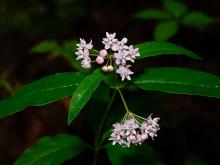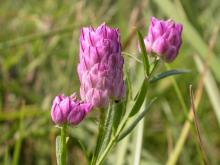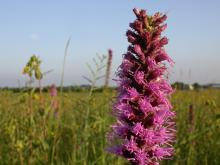Wildflowers, Grasses and Other Nonwoody Plants
Media

Species Types
Scientific Name
Asclepias verticillata
Description
Whorled milkweed has rounded clusters of small white flowers. The leaves are soft, threadlike, and grow in whorls from the stem. It occurs in upland prairies and fields.
Media

Species Types
Scientific Name
Asclepias quadrifolia
Description
One of our earliest blooming milkweeds, fourleaf milkweed bears round clusters of pink or cream-colored flowers. As the common names suggest, at least some of the leaves are arranged in whorls of 4.
Media

Species Types
Scientific Name
Asclepias hirtella
Description
Prairie milkweed’s full, rounded clusters of small, delicately purple-tinged flowers set it apart from other prairie milkweeds.
Media

Species Types
Scientific Name
Agalinis tenuifolia (formerly Gerardia tenuifolia)
Description
Slender false foxglove, or common gerardia, is a small, showy wildflower with slender, opposite leaves and thin, wiry, branching stems. The small, funnel-shaped blossoms are pink or purple, with an upper lip that arches over the 4 hairy stamens.
Media

Species Types
Scientific Name
Polygala sanguinea
Description
The dense, cylindrical flower clusters of field milkwort are pink to white and, at first glance, look something like a clover head. This small annual wildflower is common in prairies, old fields, meadows, and glades.
Media

Species Types
Scientific Name
Viola bicolor
Description
Johnny-jump-up is a flat-faced violet whose small flowers are a washed-out blue or violet with a very light yellow or white center. Look for it in fields, meadows, glades, rights-of-way, disturbed sites, and possibly your front lawn.
Media

Species Types
Scientific Name
Symphyotrichum spp. (formerly Aster spp.)
Description
Missouri has 24 species of New World asters in genus Symphyotrichum. Most have purple or white ray flowers and yellow disk flowers that turn reddish over time. Most bloom in late summer and fall.
Media

Species Types
Scientific Name
Penstemon cobaea
Description
Cobaea beardtongue, or purple beardtongue, is probably Missouri’s showiest species of penstemon. Native to Missouri's southern Ozarks, it is grown statewide for its beauty, and because pollinators like it. It may be purple or white.
Media

Species Types
Scientific Name
Liatris spp.
Description
Missouri boasts nine native species of blazing stars, or gayfeathers, in genus Liatris. These showy, upright, unbranching spikes of magenta-pink wildflowers bloom in sunny habitats.
Media

Species Types
Scientific Name
Liatris cylindracea
Description
Cylindrical blazing star is one of several Missouri native species of blazing stars, or gayfeathers. It is widely scattered in the Ozarks and eastern Missouri. Identify it by its bracts, which are pressed against the base of the flowerhead, accentuating its cylindrical look.
See Also
About Wildflowers, Grasses and Other Nonwoody Plants in Missouri
A very simple way of thinking about the green world is to divide the vascular plants into two groups: woody and nonwoody (or herbaceous). But this is an artificial division; many plant families include some species that are woody and some that are not. The diversity of nonwoody vascular plants is staggering! Think of all the ferns, grasses, sedges, lilies, peas, sunflowers, nightshades, milkweeds, mustards, mints, and mallows — weeds and wildflowers — and many more!





















